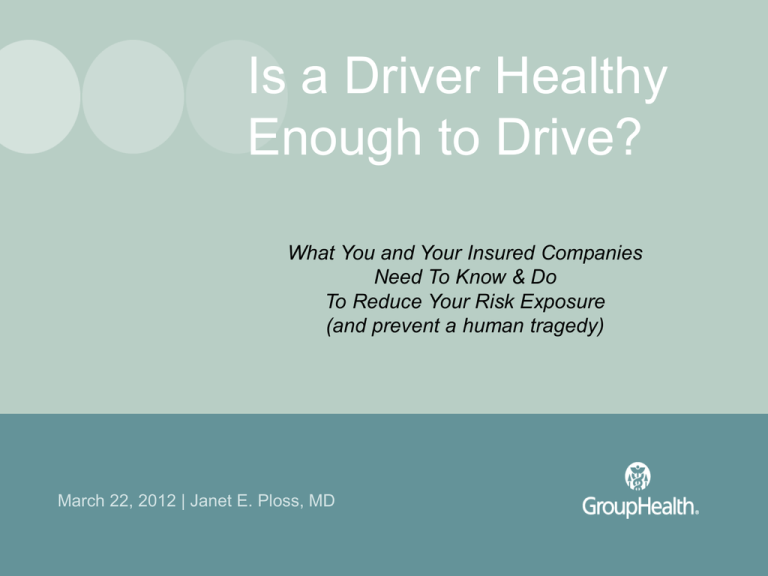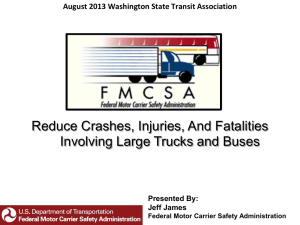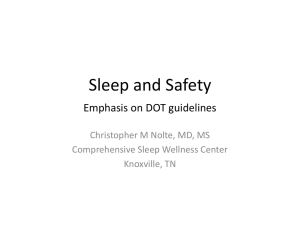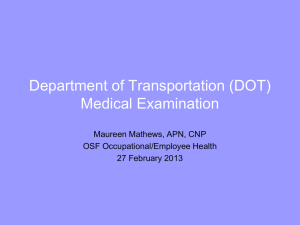DOT Medical Certification Presentation
advertisement

Is a Driver Healthy Enough to Drive? What You and Your Insured Companies Need To Know & Do To Reduce Your Risk Exposure (and prevent a human tragedy) March 22, 2012 | Janet E. Ploss, MD Outline of Presentation The Causes of Bus Crashes, especially driver-related causes Sleep Apnea The FMCSA’s Rules and Guidelines CDME Other Rules What is on the horizon? A National Registry of Certified Medical Examiners What You Can Do to Decrease Your Risk of a Driver Health Problem Causing a Bus Crash What Causes Bus Crashes? In a 2009 Study of 40 Buses involved in crashes with fatalities * In 19 the critical reason was assigned to the bus * In 15 of these, the critical reason was the driver-related inadequate surveillance 6 inattention 4 following too close 2 other 3 Health Problems Among the 40 Drivers * Prescription drug use 8 * Driver had vision problems 6 * Inattention/distraction 5 * Hearing Problems 2 What About Sleepiness & Fatigue? • Risk Factors for Sleepiness & Fatigue Causing Crashes: • Youth • Shift work • Alcohol & Drug Use • Over-the Counter and Prescription Medications Characteristics of Sleep-Related Crashes •Often associated with morbidity and mortality •Tend to occur after midnight and in the midafternoon •Typically involve a single vehicle leaving the roadway •Occur more often on high-speed roads •Sleepy drivers are like likely to take evasive action to prevent a crash •Sleepy drivers are us Reducing Sleep-Related Crashes 1. Carriers & Drivers following Hours of Services Regulations 2. Using Medical Providers for the CDME who understand and follow the Guidelines on Sleep Apnea & Prescription Drug Use Obstructive Sleep Apnea Normal Nasal & Oral Pharynx Obstructive Sleep Apnea Risk Factors for Sleep Apnea Male gender Being overweight Being over the age of forty Having a large neck size (17 inches or greater in men and 16 inches or greater in women) Having large tonsils, a large tongue, or a small jaw bone Having a family history of sleep apnea Gastroesophageal reflux, or GERD Nasal obstruction due to a deviated septum, allergies, or sinus problems BMI Chart for Men Epworth Sleepiness Scale The Epworth Sleepiness Scale is used to determine the level of daytime sleepiness. Use the following scale to choose the most appropriate number for each situation: 0 = would never doze or sleep. 1 = slight chance of dozing or sleeping 2 = moderate chance of dozing or sleeping 3 = high chance of dozing or sleeping Situation Chance of Dozing or Sleeping: Sitting and reading ____ Watching TV ____ Sitting inactive in a public place ____ Being a passenger in a motor vehicle for an hour or more ____ Lying down in the afternoon ____ Sitting and talking to someone ____ Sitting quietly after lunch (no alcohol) ____ Stopped for a few minutes in traffic While driving ____ Total score (add the scores up) (This is your Epworth score) ____ Epworth Sleep Scale Scoring ≥ 10: Sleepy, should be evaluated for possible sleep disorder ≥ 18: Very Sleepy, definitely should be evaluated by a sleep specialist Drivers Who Can Be Given a 3 month Certification Pending Further Study 1. History is Suggestive (snoring, excessive day-time sleepiness, witnessed episodes of stopping breathing) 2. Two or more of the following: a. BMI greater than or equal to 35 b. Neck circumference greater than 17” in men and 16” in women c. Hypertension (new, uncontrolled, or requiring 2 or more meds) 3. Epworth Sleep Score greater than 10 4. Previously Diagnosed Sleep Disorder 5. AHI 5 to 30, without any other factors Drivers Who Should Be Taken Out of Service Immediately 1. Observed or Confessed Unexplained Excessive Day-time Sleepiness 2. MVA likely related to sleep disturbance, unless evaluated for sleep disorder in the interim 3. Epworth Sleep Score greater than 16 4. Previously Diagnosed Sleep Disorder and a. Non-compliant b. No recent follow-up c. Surgery without follow-up 5. AHI greater than 30 Consequences of Untreated Sleep Apnea High blood pressure Stroke Heart failure, irregular heart beats, and heart attacks Diabetes Depression Worsening of ADHD Motor Vehicle Crashes Federal Motor Carrier Safety Administration (FMCSA) & Commercial Driver Medical Exam (CDME) The Federal Motor Carrier Safety Administration (FMCSA) • Established within the Department of Transportation on January 1, 2000, pursuant to the Motor Carrier Safety Improvement Act of 1999 (49 U.S.C. 113). Formerly a part of the Federal Highway Administration, the Federal Motor Carrier Safety Administration's primary mission is to prevent commercial motor vehicle-related fatalities and injuries. The mission of the FMCSA’s Office of Medical Programs is to promote the safety of America's roadways through the promulgation and implementation of medical regulations, guidelines and policies that ensure commercial motor vehicle drivers engaged in interstate commerce are physically qualified to do so. Vision Statement - All bus and truck drivers are healthy, safe and medically fit to drive. Everyone - drivers, medical examiners, bus and truck companies and the public - understands and values the importance of driver health and wellness, and our safety regulations, policies and programs. The Commercial Driver Medical Evaluation (CDME) • Long before the FMCSA, there was in 1939 the first criteria for commercial drivers: • “Good physical and mental health; good eyesight; adequate hearing; no addiction to narcotic drugs; and no excessive use of alcoholic beverages or liquors” • 1992 Amendment allowed providers other than physicians to perform CDMEs, including physicians assistants, ARNPs and some chiropractors • Medical Examiners Use a standard form in use since 2003 • 2005 Legislation mandated the establishment of a National Registry of Certified Medical Examiners (its implementation is imminent and we will be teaching a course required for those who wish to be certified) Who has to have a CDME? A CDME is required if a driver is driving a commercial motor vehicle over 10,001 lbs or is carrying 16 or more people (driver plus 15 or more passengers). Rules vs. Guidelines • Rules or non-discretionary standards exist for certain conditions • Waiver programs exist defining the requirements for making exceptions to certain rules • For many conditions panels of experts have weighed in and made recommendations upon with guidelines are based • Both the rules and the guidelines are included in the bible for examiners: The DOT Medical Examination, Fifth Edition • The author, Natalie Hartenbaum, MD, MPH is the acknowledged leading expert in the field and is the past president of the American College of Occupational and Environmental Medicine Absolute Disqualifying Conditions 1. Vision: Worse than 20/40 with or without correction in each eye; Peripheral vision less than 70 degrees in horizontal field; Inability to distinguish red, green and yellow; monocular vision (exception: state waiver provided) 2. Hearing: Forced whisper test less than five feet with or without a hearing aid 3. Diabetes: requiring insulin (exception: patient has state waiver) 4. Epilepsy: Established history or clinical diagnosis; and taking antiseizure medication 5. Hypertension: BP at or above 180/110 6. Opioids: methadone Relative Disqualifying Conditions 1. Hypertension: At or above 160/100; 3 month card, send back to PCP to get BP 140/90 or better; certify annually 2. Cardiovascular Disease: Various cardiac conditions. Cardiac bypass surgery and pacemakers are not disqualifying, but they must have a normal EKG and pass a stress test, not be on meds that would interfere with driving and be cleared by a cardiologist; certify annually. An implanted defibrillator is disqualifying. 3. Limb impairment: loss of a foot, leg, hand or arm is disqualifying unless the driver provides a Skill Performance Certificate to the examiner; certify biannually 4. Any musculoskeletal condition which could interfere with the ability to control and safely operate a motor vehicle; certify annually Relative Disqualifying Conditions 5. Mental Disorders likely to interfere with the safe operation of a commercial motor vehicle. Most psychoses are disqualifying. If stable on medications and cleared by a mental health professional, certify annually 6. Automatic disqualification for certain neurological disorders. Seizure disorder disqualifying, but if only one seizure, must be clear for five years. If history of seizure disorder, must be off meds without any seizure for 10 years. 7. Newly diagnosed diabetes not on insulin: 6 month card and monitored by PCP, then certify annually; must have evidence of being under control and understanding their disease Relative Disqualifying Conditions 8. Substance Abuse Disorders a. Any use of Schedule 1 drugs (drugs that have no purposeful medical use) is prohibited when driving a commercial motor vehicle. A present this includes marijuana, medical marijuana laws notwithstanding. b. Use of opioids, amphetamines, benzodiazepines, or any other habit-forming drug requires that the medication is prescribed by a physician who knows the patient and his or her job duties and who provides a written statement that the prescribed drug will not interfere with the driver’s ability to safely operate a motor vehicle. c. A current diagnosis of alcoholism is disqualifying. If cleared by a specialist, certify annually 8. Respiratory Dysfunction: Any respiratory disease that would be detrimental to safe driving. If a driver has such a disease, he or she must undergo lung function testing, be cleared by a pulmonary specialist and certified annually. Supplemental oxygen is disqualifying. Other Rules You Should Know About • As January 30, 2012, drivers have to go to the state agency which issues their CDL and self-certify that they are either an intrastate or an interstate driver. This has to be done by January 2014. Then interstate drivers will have to have their medical certification scanned into the CDL system, but intrastate drivers will not. What you can do to lessen the risk of driver-related bus crashes 1. Pick Occupational Health providers who are familiar with the rules and guidelines 2. Pay the cost of the CDME for those drivers who go to qualified medical providers 3. Have the driver sign a release of medical information so that the provider can let you know whether the driver passed, for what period of time and with what conditions 4. Have the medical provider notify you whenever a time-limited card is issued or a waiver is required 5. If the drivers have union representation, let the union know the negative consequences of having primary care providers do the CDME Key Resources for the CDME Federal Motor Carrier Safety Administration (http://www.fmcsa.dot.gov/) Medical examiner handbook (http://nrcme.fmcsa.dot.gov/MEhandbook.htm) Medical expert panel reports (http://www.mrb.fmcsa.dot.gov/reports.htm) Medical frequently asked questions (http://www.fmcsa.dot.gov/rulesregulations/topics/medical/faq.asp) Medical programs (http://www.fmcsa.dot.gov/rulesregulations/topics/medical/medical.htm) Key Resources for the CDME Medical reports (http://www.fmcsa.dot.gov/factsresearch/research-technology/publications/medreports.htm) Medical review board (http://www.mrb.fmcsa.dot.gov/) National Registry of Certified Medical Examiners (http://www.nrcme.fmcsa.dot.gov./index.aspx) Rules and regulations (http://www.fmcsa.dot.gov/rulesregulations/rules-regulations.htm) Hartenbaum NP, ed. The DOT Medical Examination: A Guide to Commercial Drivers' Medical Certification. 4th ed. Beverly Farms, Mass.: OEM Press; 2008. We at Group Health Occupational Health are here to help you and your bus companies with the CDME and related health issues.




